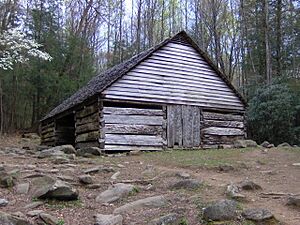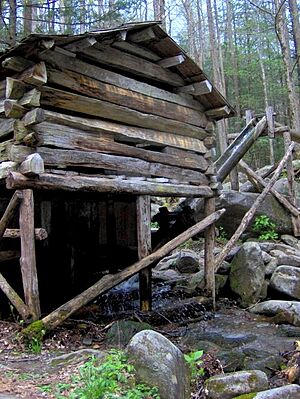Noah Ogle Place facts for kids
Quick facts for kids |
|
|
Bud Ogle Farm
|
|

Noah "Bud" Ogle cabin
|
|
| Location | 3 mi. SE of Gatlinburg |
|---|---|
| Nearest city | Gatlinburg, Tennessee |
| NRHP reference No. | 77000158 |
| Added to NRHP | November 23, 1977 |
The Noah "Bud" Ogle Place is a historic farm located in the beautiful Great Smoky Mountains of Sevier County, Tennessee. This special place includes a cabin, a barn, and a unique "tub mill." These buildings were constructed by a mountain farmer named Noah "Bud" Ogle (who lived from 1863 to 1913) in the late 1800s.
In 1977, the Noah "Bud" Ogle Place was added to the National Register of Historic Places, which means it's recognized as an important historical site. Today, the Great Smoky Mountains National Park takes care of it, so visitors can still see what a mountain farm was like long ago.
The buildings you see at the Noah Ogle Place show what a typical farm in the Southern Appalachian Mountains looked like in the 19th century. Noah Ogle's cabin is a special type called a "saddlebag" cabin. This means it's like two small cabins joined together by one chimney. His barn is also unique, being the last "four-pen" barn left in the park. The tub mill is even more rare – it's the last working tub mill in the park and one of the few still operating in the whole region!
Contents
Where is the Ogle Farm?
The Noah Ogle Place is found near a stream called LeConte Creek. It's located in the upper part of the West Fork of the Little Pigeon River. The town of Gatlinburg is to the north, and the famous Mount Le Conte mountain is to the south.
You can reach the Noah Ogle Place by taking Cherokee Orchard Road. This road connects the farm to U.S. Route 441 in downtown Gatlinburg. The tub mill, which is part of the farm, is located about half a mile away from the cabin and barn, right on the banks of LeConte Creek.
History of the Ogle Farm
Noah Ogle's great-grandparents, William and Martha Ogle, were among the very first European settlers in the Gatlinburg area. They arrived in the early 1800s. Their original cabin can still be seen today in downtown Gatlinburg! As the Ogle family grew, they spread out into the nearby valleys.
Noah Ogle's farm originally covered about 400 acres. Later, he divided some of his land among his children, keeping about 150 acres for himself. This remaining 150 acres is what makes up the historic district you can visit today.
Noah Ogle built his cabin and other farm buildings in the late 1880s and early 1890s. The land was quite rocky, so it wasn't the best for farming. Noah mostly grew corn, but he also had a large apple orchard with many different kinds of apples. His relatives could use his tub mill for free, while others paid a small amount of their ground meal. Any extra corn and apples were sent to markets in Knoxville. Noah's wife, Lucinda Bradley Ogle, was a local midwife, helping families in the area.
Besides the main cabin and barn, Noah's farm also had a "weaner cabin." This was a small cabin near the main house where the farmer's children could live for a short time after they got married. Some of Noah's sons lived in the Ogle weaner cabin after their weddings. The weaner cabin is no longer standing, but you can still see some of its old foundation.
In the 1920s, a large commercial apple orchard and plant nursery called "Cherokee Orchard" was started near the Ogle farm. When the state of Tennessee began buying land to create the national park, the owners of Cherokee Orchard were worried their land would be taken. They eventually agreed to let their land become part of the park in 1931, in exchange for a long lease to continue their business.
Exploring the Historic Buildings
Noah Ogle's Saddlebag Cabin
The Noah Ogle cabin is a special type called a "saddlebag" cabin. It's made up of two separate cabins that share one chimney in the middle. The first cabin was built, and then about five years later, the second cabin was added as Noah's family grew.
Both cabins are about 18 feet by 20 feet and have one main floor plus a loft upstairs. The walls are made of carefully cut logs that fit together with "half-dovetail notches." There are six doors in the cabin, allowing easy movement between the two parts. The roof is made of split-oak shingles, and the floors are made of sawn boards. The fireplaces are built from rubble stones.
At first, the cabin's windows had shutters, but later glass windows were put in. One interesting feature is a small window near the floor in one cabin, which allowed chickens to come inside to escape predators! A covered porch stretches across both the front and back of the cabin, providing a nice outdoor space.
The Ogle Barn
The Ogle barn is the last "four-pen" barn remaining in the Great Smoky Mountains National Park. It has four separate sections, or "pens," each about 11 feet square. Each pen has one story and a loft above it. The entire barn is covered by a roof made of split shingles. Just like the cabin, the barn's walls are built from cut logs that fit together with half-dovetail notches. The park service has made many repairs to the barn over the years to keep it in good condition.
The Ogle Tub Mill
Noah Ogle's tub mill is truly unique! It's the last of at least 13 tub mills that once operated along LeConte Creek. The millhouse is a small building, about 11 feet by 11 feet, that sits on log supports above LeConte Creek. It's located about half a mile from the Ogle cabin and barn.
The walls of the mill are made of logs connected with "saddle notches," and the floor is made of hewn logs. Inside, a vertical shaft connects the grindstones (which crush grain) to a "tub wheel" turbine below. Water from the creek is diverted through an 80-foot-long hollowed-log channel, called a flume, to spin the turbine. This spinning turbine then turns the grindstones, allowing the mill to grind corn and other grains. The mill was fixed up in the 1960s and can still operate today!





